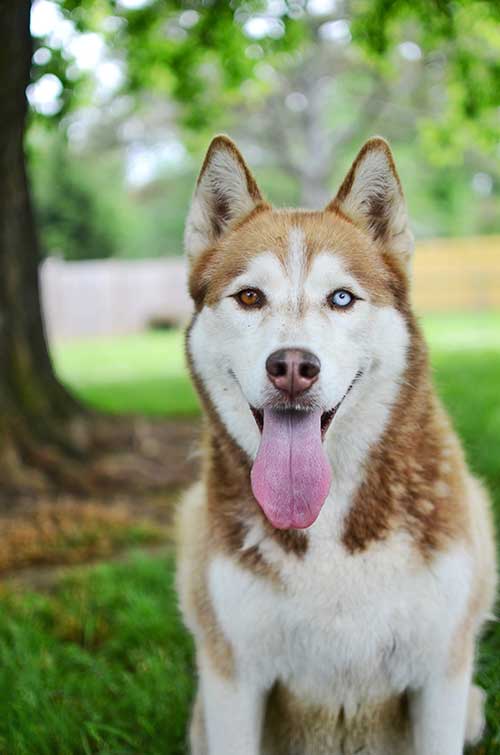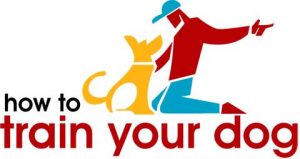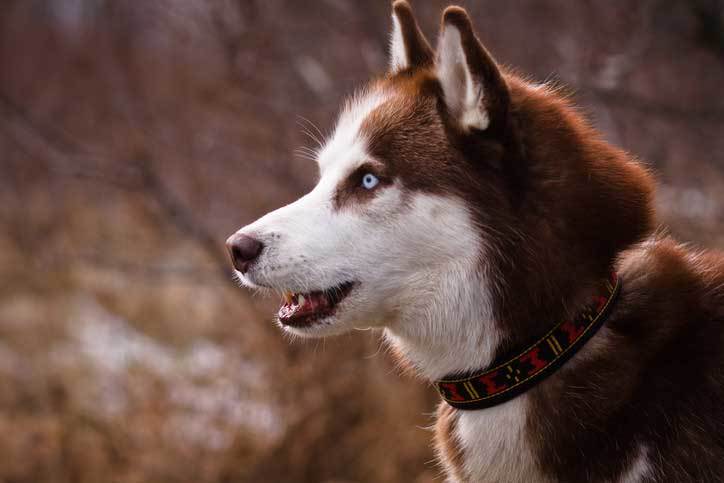Siberian Huskies come in a range of colors, including black and white, white and grey and copper.
Although the darker colored Huskies are more common, the Red Huskies are becoming more and more popular.
The Red Siberian Husky is a very beautiful dog. With his wolf-like shape, majestic coat and beautiful brown and blue eyes, it’s difficult not to fall in love with this dog the moment you come across one.
Here, you’ll learn more about the red coloring and what to expect if you’re looking to adopt or buy a Red Husky puppy.
An Overview
First and foremost, the red coloring is not something new in Huskies. In fact, it is a natural variation that is caused by a recessive gene.
While the black color is the result of a dominant gene, and therefore, more common, Huskies may carry the red coloring gene, which is then passed on to their offspring.
If one or both parents are carrying the recessive gene, then the puppies may have a red coat, even if both parent dogs are black.
It is important to keep in mind that the red coloring is not definitive. Here, “Red” ranges from light red to copper.
As you can see, Husky colors are varied, with big differences to be seen between individual puppies. The most common colors are black and white, white, red, and copper.
While Copper Huskies are not recognized by the AKC as standard, they are still an amazing variation of this breed.
The difference between the Red Husky and the Copper Husky is that the red ones are normally darker. There are also Brown Huskies and Chocolate Red Huskies.
Are Red Huskies Rare?
While the red-colored coat is not as common as other variations of the breed, Red Huskies are not rare and you can find them around the country.
The History of the Siberian Husky
The Chukchis are believed to have used Siberian Huskies as sleigh dogs sometime in the 19th century.
Both the Chukchis and the dogs lived harmoniously with each other and continued to rely on each other to survive harsh conditions.
Siberian Huskies are said to have arrived in Alaska in 1925 when they were still known as Chukchis. Since these dogs were extremely fast, they were commonly used to pull sleds during popular sporting events. It was during this period of time that these dogs were first called “Siberian Huskies”.
Huskies are one of the oldest dog breeds in the world and the dogs remain much the same as the ones witnessed way back in the 19th century.
The present-day Siberian Husky is calm, friendly, and loyal, making him a great choice for dog owners around the world. He is one of the most popular breeds of dogs recognized by the AKC.

Some Quick Facts About The Red Husky
| Size: | Medium-sized dog |
| Good Watch Dog: | Yes |
| Good Guard Dog: | No |
| Average Weight: | Males: 45 to 60 pounds, Females: 35 to 50 pounds |
| Average Height: | Males: 21 to 23 inches, Females: 20 to 22 inches |
| Lifespan: | 12 to 15 years |
| Apartment Living: | Yes, if given enough exercise and training to release their pent up energy |
| Ideal for: | For Individuals and Active Families, Spacious homes, Experienced owners, Homes with Multiple Dogs |
| Coat: | A beautiful medium length, thick double coat |
| Coat colors: | Copper, Chocolate, Brown |
| Suitable for first-time owners: | No |
| Trainability: | Difficult |
| Hypoallergenic: | No |
| Shedding: | Heavy |
| Grooming Needs: | Weekly brushings help keep the coat and skin in good condition (Daily brushing is recommended during the shedding seasons) |
| Energy Levels: | High |
| Exercise Needs: | At least 2 hours of exercise every day is required |
| Tolerance to being left alone: | Low, should not be left alone for more than 6 to 8 hours |
| Feeding and Diet: | 1.5 to 2 cups of high-quality dry dog food each day, divided into two or three meals |
| Maintenance | High |
| Possible Health Issues: | Bloat, Hip Dysplasia, Cataracts, Progressive Retinal Atrophy, Corneal Dystrophy, Hypothyroidism |
| Temperament: | Intelligent, Friendly, Outgoing, Alert, Gentle, Stubborn, Affectionate, Athletic, Good-Natured with Strangers, Clever Escape Artists, Free-Spirited, Loyal |
| Cat Friendly: | Moderate, they have high prey drive which means that they will often chase smaller animals |
| Dog Friendly: | Yes, But Proper Socialization Is Recommended |
| Kid Friendly: | Yes, But Proper Socialization Is Recommended |
| Barking Tendencies: | Rare |
| Price: | $500 to $1,500 |
How Big Does A Red Husky Get?
As with any dog, it’s important to know the physical characteristics of the red Siberian Husky.
Generally, males reach a height of 21 to 23 inches while females grow to a height of 20 to 22 inches.
When it comes to weight, males will weigh anywhere between 45 and 60 pounds while females will weigh around 35 to 50 pounds.
The Red Siberian Husky Behavior & Temperament
It is also important to understand the behavior and temperament of these dogs before you bring one home.
There are several behavior and personality traits that you should know more about as you socialize and train your Husky.
Huskies are lively, high-energy dogs that tend to get bored quite easily. That’s why your Red Husky puppy may chew on your shoes and furniture if left alone for an extended period of time.
These dogs are also intelligent and strong-minded. This can make them excellent family pets but can also make them very hard to train.
They are loving, friendly and loyal. Huskies are pack animals and thrive in a family environment. They are also gentle with children and strangers.
Huskies rarely bark, which is some good news. However, they may howl very loudly. Proper training can help correct this behavior.
Training
As with any dog, housebreaking your Red Siberian Husky is a must. A puppy needs to urinate or defecate more often than a full-grown dog.
When your dog learns to go outside, encourage the good behavior with praises and treats. This will let him know where to do his business, and help reinforce the acceptable behavior.
Huskies usually enjoy training sessions since they are intelligent work dogs. Be patient and consistent. Your puppy can learn new tricks and commands if you are patient and consistent.
Make sure to introduce your puppy to different people and other animals. While these dogs are naturally friendly, your puppy will still require socialization to remain comfortable around different people and other pets.
Socializing your puppy will have a big impact on his personality and behavior later in life. Unwanted behaviors like barking and biting are sometimes a result of improper socialization.
Exercise Requirements
Give your Red Husky puppy plenty of exercise. These dogs are active and energetic, so you need to exercise them each day to expend excess energy.
Huskies were bred to be work dogs, which means that they can get bored if they don’t have a job to do.
To keep your dog happy and healthy, make sure he gets at least 2 hours of exercise each day.
Huskies are excellent dogs to run or jog with, especially when they get older. These dogs love to play, run, and to chase things around.
If he doesn’t get enough exercise on a daily basis, the consequence is a bored dog that destroys your home and howls continuously.
You should also provide your dog with interactive dog toys to keep them mentally stimulated and tired.
Grooming and Shedding
You should brush his thick coat at least once per week. Then clean and check his ears.
Bathing should also be done every two months or when your dog gets dirty. If you bathe them more frequently, you risk depleting their natural skin oils. Try to use deodorizing wipes for dogs regularly to prevent unpleasant odors.
During the shedding season, you should brush him daily to help minimize shedding.
Their nails also need to be trimmed at least once a month to prevent splitting, cracking and further discomfort.
Feeding Information
Feed your Red Haired Husky three times a day. Feed a high-quality dry dog food with no artificial additives.
Providing food at specific times, and removing the dish once he is done eating can be a great way to show your dog that you are in control.
While treats are recommended, you should watch his calorie intake to avoid making your dog overweight.
Your red Husky will also require probiotics and wild Alaskan salmon oil to maintain their coat as well as their overall health. And don’t forget to give this high-energy dog fresh water every day to prevent dehydration.
Health Issues
Because of this breed’s susceptibility to eye problems, it is extremely important to get your dog’s eyes checked.
Specifically, Huskies are prone to cataracts, cornea dystrophy, and progressive retinal atrophy. These health conditions are often genetic.
Find out as much as you can about your new puppy’s parent dogs to determine if he is likely to suffer from any of these conditions.
Red Husky Life Expectancy
The average lifespan of a red Siberian Husky is around 13 years, just like other medium-sized dogs. Many of these dogs live even longer than that.
It’s essential to ensure proper care regarding their food, grooming, and exercise requirements to prolong their lifespan.
- ACTIONABLE HEALTH INSIGHTS: Test for over 270 genetic health conditions and get actionable insights to help you give your pup the best care possible….
- MOST ACCURATE BREED IDENTIFICATION: Test for over 350 dog breeds including dingoes, coyotes, wolves, and village dogs. Using a research-grade…
- TRAIT INSIGHTS THAT HELP YOU BE MORE PREPARED: Test for 55 physical traits. Size, coat, grooming needs — your dog’s traits don’t just make them…
Last update on 2025-01-13 / Affiliate links / Images from Amazon Product Advertising API
Finding Red Husky Puppies For Sale
When searching for red Husky puppies for sale, it’s extremely important to choose a reputable breeder.
Avoid promoting puppy mills, pet stores or backyard breeders at all costs. Such sources usually sell low quality or unhealthy puppies.
By going through a responsible breeder, you will know exactly what you are getting.
Ask your breeder a few questions to ensure the red husky is a good match for you and your family.
Are Red Huskies More Expensive?
Although no one can put an actual price on unconditional love and support, purebred Red Husky puppies for sale can attract a huge amount of money.
You should expect to pay around $600 for one of these puppies. If the puppy’s parents are winning sled or show dogs, then you can pay as high as $1500.
Make sure to buy your puppy from reputable Red Husky breeders with a record of delivering healthy, quality and ideal puppies.
Apart from the cost of buying a puppy, you want to factor in food costs, vet fees and pet products like the MidWest Folding Crate for Intermediate dogs and the Furhaven Orthopedic dog bed from reputable retailers like Amazon.
Finding A Red Husky for Adoption
You could find a red Husky listed for adoption in a rescue or shelter. Rescuing a dog has a number of benefits. It’s a fulfilling experience to give a loving home to a pup in need.
Moreover, adopting a dog is usually cheaper than buying one from a reputable breeder. Nonetheless, there are a few cons, as well. You won’t know the dog’s history as you would when going through a local breeder.
Can Red Huskies Be Left Alone?
No. These dogs do not tolerate being left alone for long hours – 6 to 8 hours is the maximum for adult red Huskies, while puppies can be left alone no longer than 2 to 3 hours a day!
As with most breeds, these dogs can become bored if left alone for too long. They need to get plenty of attention from their owners and family.
Are Red Huskies Hard to Train?
Red Siberian huskies are known to be stubborn, independent, and strong-willed which makes them difficult to train and challenging breed for first-time dog owners with no experience in dog training.
Are Red Huskies Good for Apartment Living?
The answer is not a simple yes or no, they are not usually the ideal dogs to live in an apartment. However, they are happy living in an apartment provided they get enough exercise and have enough room to roam around.
Are Red Huskies High Maintenance?
Yes, Their exercise and grooming needs are high. Also if left alone for too long they can become mischievous and destructive.
Another thing to keep in mind is that they are not easy to train. We don’t recommend this breed for first-time dog owners with no experience in dog training.
Are Red Huskies Good With Kids?
Yes, Red Huskies are friendly dogs who get along well with children. They are tolerant of kids, but as with all other canines, should be supervised when playing with small kids.
Are Red Huskies Stubborn?
Yes. The red Husky is an active dog with a working background. They are also clever and stubborn so they need a firm owner who they will respect.
Is A Red Siberian Husky Right for You?
If you’re searching for a good family dog who is playful, friendly and energetic, a red husky might be a good choice for you. Red husky dogs are adorable pups and can be wonderful companions, especially if properly trained and socialized.
However, you should be able to provide them with the mental and physical stimulation these dogs require. If you’re not up for this challenge, then you need to think twice before buying a red Husky puppy.
In conclusion, the above facts and information should enable you to understand the Red Siberian Husky dogs so you can train and take proper care of your puppy.
Checkout Our Favorite Dog Products
1. BEST PUPPY TOY
We Like: Snuggle Behavior Toy with Heart Beat & Heat Pack – Ideal toy for new puppies.
2. BEST DOG TRAINING PROGRAM
We Like: Doggy Dan The Online Dog Trainer – Stop any dog problem and raise the perfect puppy with The Online Dog Trainer.
3. BEST DOG PUZZLE TOY
We Like: Outward Hound Interactive Puzzle Toy – Every dog loves chasing squirrels at the park. The Outward Hound Hide-a-Squirrel Puzzle Toy gives your dog the same feeling as though he was outdoors chasing live squirrels.
4. Best Bone Broth for Dogs
We Like: (Solid Gold – Human Grade Bone Broth for Dogs) – Simmered Beef Bone Broth With Turmeric Provides A Nutrient-Dense And Flavorful Addition To Your Dog’s Meal + Rich In Natural Collagen From Beef Bones.
5. Best Multivitamin for Dogs
We Like: PetHonesty 10-For-1 Multivitamin – 10 Benefits in 1 Daily Treat – These Multivitamin Snacks combine a well-rounded blend of the most essential vitamins and supplements including glucosamine, probiotics, vitamins and omegas, for dogs’ overall daily health.






 (@siberianhuskyaspen)
(@siberianhuskyaspen)